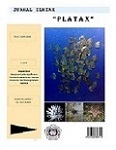Mangrove Community Characteristics and Local Fishermen’s Utilization in North Sulawesi Province: Case study on boat raft fishermen in Sauk village, Labuan Uki bay, Bolaang Mongondow regency
DOI:
https://doi.org/10.35800/jip.4.2.2016.19011Abstract
This study aims to analyze the characteristics of mangrove vegetation in Sauk village, Labuan Uki bay, and to know the exploitation activities and the community’s perception on mangrove ecosystem. Mangrove vegetation characteristic data were collected using transect line method in 3 stations, while mangrove utilization and community’s perception data were obtained through field observation, questioners, and structured interviews. Respondent sampling used purposive sampling, and the respondents were representatively selected based on profession background as boat raft fishermen.
Results showed that mangroves in Sauk village consisted of 8 species, Avicennia officinalis Aegiceras floridum, Rhizophora apiculata, R. mucronata, R. stylosa, Bruguiera gymnorrhiza, Sonneratia alba, and S. casiolari. The density level was 689 trees.ha-1 (categorized as rare according to the decree of Living Evironment Minister Numbered 201/2004) and the mean vegetation spread was 95.16 M widely available from 22.70 Ha.
People used the mangrove for firewood, building materials, boat frame, fish drying place, net dye material (tree skin), dahannya dibuat wadah bunga buatan, and fishing ground. Some people of the village clear cut the mangroves for boat sailing route, despite violating Indonesian Law numbered 27/ 2007 jo Low numbered 1/2014 concerning coastal area and small islands management.
Sixty percent of the respondents understood that mangroves can be cut for various benefits, 40% knew that mangrove area is source of income, 40% as source of firewood, 10% as place where fish lay their eggs, and 10% as coast protection from abrasion.
Keyword : mangrove, boat raft fishermen, Sauk village, Labuan Uki bay.
ABSTRAK
Penelitian ini bertujuan untuk  menganalisis karaktersitik vegetasi mangrove yang ada di desa Sauk Teluk Labuan Uki dan mengetahui aktivitas pemanfaatan serta persepsi masyarakat tentang ekosistem mangrove. Data karakteristik vegetasi mangrove diambil menggunakan metode transek line di 3 stasiun. Sedangkan data pemanfaatan mangrove dan persepsi masyarakat dikumpulkan melalui teknik observasi lapangan, pengisian kuesioner dan wawancara terstruktur. Pengambilan sampel responden menggunakan metode purposive sampling. Responden dipilih secara representatif berdasarkan latar belakang profesi sebagai nelayan bagan perahu
Hasil penelitian menggambarkan bahwa mangrove yang ada di desa Sauk terdiri dari 8 spesies : Avicennia officinalis (api-api), Aegiceras floridum (api-api), Rhizophora apiculata (lolaro), Rhizophora mucronata(lolaro), Rhizophora stylosa (lolaro), Bruguiera gymnorrhiza (ting), Sonneratia alba (lolaro) dan Sonneratia casiolari (posi-posi). Tingkat kerapatan 689 pohon/ha (kategori jarang sesuai Kepmen Lingkungan Hidup No 201 Tahun 2004). Ketebalan vegetasi mangrove rata2 95,16 meter dari luas yang tersedia 22,70 Ha.
Masyarakat memanfaatkan mangrove untuk : sumber kayu bakar, dibuat bahan bangunan, dibuat rangka kapal, tempat menjemur ikan, kulitnya sebagai pewarna jaring, dahannya dibuat wadah bunga buatan, tempat menangkap ikan dan biota air lainnya. Selain itu ada oknum masyarakat desa Sauk yang menebang mangrove untuk membuat lintasan perahu, dimana kegiatan ini bertentangan dengan UU No.27 Tahun 2007 jo UU No.1 Tahun 2014 tentang Pengelolaan Wilayah Pesisir dan Pulau2 Kecil. 60 % responden memahami bahwa mangrove adalah tumbuhan yang bebas ditebang untuk dimanfaatkan berbagai kepentingan. 40 % responden memahami kawasan mangrove adalah sumber pencaharian masyarakat lokal, 40 % responden memahami sebagai sumber untuk mencari kayu bakar, 10 % responden memahami sebagai tempat bertelur ikan, dan 10 % responden memahami sebagai penahan abrasi pantai.
Keyword : mangrove, nelayan bagan perahu, desa Sauk, Teluk Labuan UkiDownloads
Published
How to Cite
Issue
Section
License
COPYRIGHT
Authors who publish with this journal agree to the following terms:
Authors hold their copyright and grant this journal the privilege of first publication, with the work simultaneously licensed under a Creative Commons Attribution License that permits others to impart the work with an acknowledgment of the work's origin and initial publication by this journal.
Authors can enter into separate or additional contractual arrangements for the non-exclusive distribution of the journal's published version of the work (for example, post it to an institutional repository or publish it in a book), with an acknowledgment of its underlying publication in this journal.
Authors are permitted and encouraged to post their work online (for example, in institutional repositories or on their website) as it can lead to productive exchanges, as well as earlier and greater citation of the published work (See The Effect of Open Access).






































